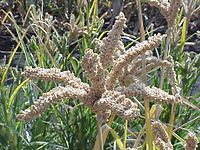
Photo from wikipedia
Abstract Drought is a substantial threat to cereal production under global climatic change scenarios, albeit its aftermath on arthropod pests is yet contentious. To address this issue, demographic characteristics of… Click to show full abstract
Abstract Drought is a substantial threat to cereal production under global climatic change scenarios, albeit its aftermath on arthropod pests is yet contentious. To address this issue, demographic characteristics of Metopolophium dirhodum (Walker, 1849) (Hemiptera: Aphididae) were studied on one drought-susceptible wheat cultivar and one drought-tolerant wheat cultivar under different water treatments. Some physiological and biochemical features of wheat cultivars including leaf soluble sugar and proline contents and antioxidant enzymes activities were also investigated. Significant differences occurred in the developmental period, survival, and fecundity of M. dirhodum between wheat cultivars under various water treatments. The impact of intermediate and severe water stress on M. dirhodum was neutral and negative for the tolerant cultivar and negative for the water-susceptible cultivar, respectively. Under severe water stress, on both wheat cultivars, the aphids had low net reproductive rates and finite and intrinsic rates of increase in comparison with those reared on unstressed plants. In total, drought resulted in lower growth of population and reduced survival of aphids. Hence, in the context of projected climatic changes, acute water deficiency could probably result in reducing the abundance and menace of outburst of M. dirhodum. However, it should be noted that the potential likelihood of M. dirhodum eruptions can be drastically affected by the degree of drought intensity and host plant cultivar.
Journal Title: Bulletin of Entomological Research
Year Published: 2022
Link to full text (if available)
Share on Social Media: Sign Up to like & get
recommendations!